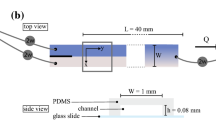Summary
The importance of smoking as a possible factor in coronary heart disease (CHD) may be related to the effect of carbon monoxide (CO) on oxygen exchange at the hemoglobin molecule (Hb). We examined the kinetics of this process in vitro and ex vivo using a fast-reaction technique (stopped-flow) whereby the dissociation-rate constant of oxygen was determined in the blood of smokers and non-smokers and at fixed HbCO-concentrations in non-smokers blood. In non-smokers, carbon monoxide saturated blood was obtained by gassing with carbon monoxide and mixing the samples with appropriate carbon monoxide free blood to achieve HbCO-concentration in the range of 10–60%. The reaction time course for the oxygen-dissociation was divided into a non-linear-initial phase (loss of the first oxygen molecule) and a subsequent linear phase. The oxygen-dissociation velocity decreased from 96.5 × 103 ms−1 to 42.7 × 103 ms−1 in the linear phase at pH 7.4 and decreased from 29.2 × 103 ms−1 to 20.9 × 103 ms−1 at pH 9.2 when the HbCO-concentration was increased to 63%. For the initial phase at pH 7.4, the dissociation velocity decreased depending on the HbCO-concentration. In non-smokers 50% of the bound oxygen was released in 17.5±2.3 ms (n = 13) whereas in smokers 19.4±1.8 ms (n = 14) (p<0.05) was required. For non-smokers the initial reaction proceeded with a dissociation-rate constant of k = 50.4±11.9 × 103 ms−1 (n = 13), in smokers this process was slower (k = 42.7±5.9 × 103 ms−1 (n = 14) (p<0.05). In the latter phase the reaction (occuring over 14–30 ms) the rate of oxygen-release in smokerswas also reduced (k = 77.1±7.3 × 103 ms−1 versus k = 85.1±13.7 × 103 ms−1; p = 0.05). These differences were presumably due to the presence of 8.9±2.3% (n = 14) HbCO in smokers. In non-smokers theHbCO-concentration was 0.81±0.11% (n = 13). These results support the view that increased HbCO-levels are responsible for a decreased oxygen capacity and a slower oxygen dissociation-rate from hemoglobin in smokers. This phenomenon can impair oxygen availability in CHD patients who smoke.
Similar content being viewed by others
References
Allred EN, Bleeker ER, Chaitman BR (1989) Short-term of carbon monoxide exposure on the exercise performance of subjects with coronary artery disease. N Engl J Med 321:1426–1432
Aronow WS (1981) Aggravitation of angina pectoris by two percent carboxyhemoglobin. Am Heart J 101:154–157
Aronow WS, Stemmer EA, Isbell MW (1974) Effect of carbon monoxide exposure on claudicatio intermittent. Circulation 49:415–417
Baldwin JM (1976) A model of co-operative oxygen binding to hemoglobin. Br Med Bull 32:213–219
Bunn HF, Forget BG (1986) Carboxyhemoglobin and carboxyhemoglobinemia. In hemoglobin: molecular, genetic and clinical aspects. WB Saunders, Philadelphia, pp 663–675
Dalziel K, O'Brian JRP (1961) The kinetics of desoxygenation of human haemoglobin. Biochem J 78:236–245
Gillis CN (1985) Peripheral metabolism. In: Vanhoutte PM (ed) Serotonin and the cardiovascular system. Raven Press, New York, pp 27–35
Opitz K (1989) Pharmakologie des Rauchens. In: Buchkremer G Rath N (eds) Raucherentwöhnung, psychologische und pharmakologische Methoden. Thieme, Stuttgart New York, pp 4–11
Perutz MF (1970) Steriochemistry of cooperative effects in haemoglobin. Nature 228:726–739
Roth H (1930) Zur jodometrischen Analyse eines Gemenges von Hydrosulfit, Sulfit und Thiosulfat. Z Anal Chem 80:1–4
Roughton FJW, Gibson QH (1954) The dissociation of the first oxygen molecule from fully saturated oxyhaemoglobin in sheep blood solutions. Proc Roy Soc B 143:310–334
Sheps SD, Herbst MC, Hinderliter AL, Kirkwood FA, Ekelund LG, O'Neil JJ, Goldstein GM, Bromberg PA, Dalton BS, Ballenger MN, Davis SM, Koch GG (1990) Production of arrhythmias by elevated carboxyhemoglobin in patients with coronary artery disease. Ann Intern Med 113:343–351
Wald N, Howard S, Smith PG Kjeldsen K (1973) Association between atherosclerosis diseases and carboxyhemoglobin levels in tabacco smokers. Br Med J 1:761–766
Wilhelmsen L (1988) Coronary heart disease: Epidemiology of smoking and intervention studies of smoking. Am Heart J 155:242–249
Woljtaczak-Jaroszowa J, Kubow S (1989) Carbon monoxide, carbon sulfide, lead and cadmium-four examples of occupational toxic agents to cardiovascular disease. Med Hypotheses 30:141–150
Author information
Authors and Affiliations
Additional information
Send offprint requests to N. Rietbrock at the above address
Rights and permissions
About this article
Cite this article
Rietbrock, N., Kunkel, S., Wörner, W. et al. Oxygen-dissociation kinetics in the blood of smokers and non-smokers: interaction between oxygen and carbon monoxide at the hemoglobin molecule. Naunyn-Schmiedeberg's Arch Pharmacol 345, 123–128 (1992). https://doi.org/10.1007/BF00175479
Received:
Accepted:
Issue Date:
DOI: https://doi.org/10.1007/BF00175479




